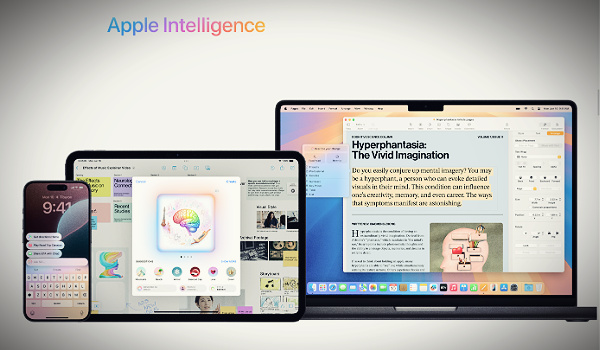Each week we find a new topic for our readers to learn about in our AI Education column.
This week, we are looking into the recently launched “Apple Intelligence” platform. As the AI ecosystem grows, it becomes an increasingly crowded space and it’s harder and harder to differentiate where any one system has an advantage over another. And yet, the news of this latest Apple update was splashed all over the business press this past week, because, of course, it came from Apple.
We’ve long seen this in the wealthtech space, which we cover extensively on Digital Wealth News. Lots of players in lots of segments. What’s the real differentiation? It becomes very difficult to discern measurable differences, which is why we try to do so as simply as possible each week with these columns.
As per usual, we rely on a generative AI to help us write the meat of this content, and below is as good of an explanation as we’ve seen yet on the new Apple Intelligence ecosystem, the changes to Siri in this latest update, and it’s improved integrations and inter-operability, delivered to us by ChatGPT this week. READ UP!!
Apple, since its inception, has always been at the forefront of technological innovation, continually pushing the boundaries to enhance user experience. In its latest stride, Apple has announced “Apple Intelligence,” a groundbreaking AI initiative that promises to redefine how users interact with their devices. This new offering marks a significant evolution from Apple’s previous AI efforts, introduces transformative changes to Siri, and presents a formidable competitor to existing mobile AI technologies such as Qualcomm’s Snapdragon on Samsung devices.
Evolution from Previous AI Offerings
Apple’s journey into the realm of artificial intelligence has been a gradual and strategic progression. Historically, Apple has integrated AI capabilities primarily through features like Siri, machine learning enhancements in the camera and photo apps, and proactive suggestions across its ecosystem. However, Apple Intelligence represents a comprehensive, integrated AI platform rather than a collection of discrete AI-powered features.
One of the key distinctions of Apple Intelligence is its depth of integration and the scope of its capabilities. Unlike previous iterations, where AI functionalities were often siloed within specific applications, Apple Intelligence is designed to permeate every aspect of the Apple ecosystem. This new AI framework leverages advanced machine learning algorithms, neural networks, and real-time data processing to deliver a more cohesive, intuitive, and responsive user experience.
Transformative Changes to Siri
Siri, Apple’s voice-activated virtual assistant, has been a staple of the company’s AI endeavors since its introduction in 2011. While Siri has seen incremental improvements over the years, Apple Intelligence brings a transformative overhaul to this familiar feature.
With Apple Intelligence, Siri becomes more than just a voice assistant; it evolves into a fully-fledged intelligent companion. Key enhancements include:
- Contextual Understanding: Siri now possesses a deeper contextual awareness, allowing it to understand and process complex queries more accurately. It can maintain context across multiple interactions, enabling more natural and fluid conversations.
- Personalization: Leveraging machine learning, Siri can now provide highly personalized responses and suggestions based on individual user preferences, habits, and routines. This personalization extends across Apple’s ecosystem, from reminders and calendar events to music and app recommendations.
- Proactive Assistance: Siri’s proactive capabilities are significantly enhanced. It can now anticipate user needs, offering timely suggestions and performing tasks without explicit prompts. For instance, Siri might suggest leaving early for a meeting based on traffic conditions or remind users of upcoming deadlines and appointments.
- Enhanced Multimodal Interactions: Apple Intelligence allows Siri to seamlessly integrate voice, text, and touch inputs. Users can switch between these interaction modes effortlessly, creating a more versatile and accessible user experience.
Genmoji
Apple Intelligence also unveiled its latest innovation, Genmoji, a groundbreaking feature designed to revolutionize digital communication, in its recent release. Genmoji leverages advanced artificial intelligence to create personalized, animated emojis that capture users’ unique facial expressions and emotions in real-time. This feature aims to enhance user engagement and interaction, providing a more immersive and expressive communication experience. By integrating seamlessly with Apple’s ecosystem, Genmoji is set to attract a broad user base, potentially driving increased device sales and boosting Apple’s market position in the competitive tech landscape.
Comparison with Other Mobile AI Offerings
Apple Intelligence is not entering a vacuum; it faces stiff competition from other mobile AI technologies, notably Qualcomm’s Snapdragon platform, widely used in Samsung devices. While both Apple Intelligence and Snapdragon AI aim to enhance mobile user experiences, they differ in several key areas.
- Integration and Ecosystem: Apple Intelligence benefits from Apple’s vertically integrated ecosystem. This tight integration ensures that AI capabilities are uniformly and consistently applied across all Apple devices, from iPhones and iPads to Macs and the Apple Watch. In contrast, Snapdragon AI, while powerful, operates within a more fragmented ecosystem, as it must cater to a variety of manufacturers and device configurations.
- Privacy and Security: Apple has long prioritized user privacy, and Apple Intelligence continues this commitment. AI processing is designed to occur primarily on-device, minimizing the need to transmit data to external servers. This approach enhances privacy and security, ensuring user data remains protected. While Snapdragon also emphasizes security, Apple’s approach is often seen as more robust due to its control over both hardware and software.
- User Experience and Accessibility: Apple Intelligence aims to deliver a seamless, intuitive user experience that feels natural and integrated. The enhancements to Siri, proactive assistance, and multimodal interactions contribute to a more cohesive and user-friendly interface. Snapdragon AI, while highly capable, often depends on the implementation choices of individual manufacturers, which can lead to variability in user experience.
- Performance and Efficiency: Both Apple Intelligence and Snapdragon AI are designed to optimize performance and efficiency. However, Apple’s control over its hardware and software allows for more fine-tuned optimizations. The new AI capabilities are tailored specifically to Apple’s A-series chips, ensuring maximum performance with minimal impact on battery life.
Conclusion
Apple Intelligence marks a significant leap forward in the realm of artificial intelligence, offering a more integrated, personalized, and responsive user experience. Its deep integration with the Apple ecosystem, enhanced capabilities of Siri, and commitment to privacy set it apart from previous AI offerings and its competitors. As Apple continues to innovate and refine its AI technologies, users can expect an ever-evolving landscape of intelligent, intuitive interactions across their devices.
DWN & ChatGPT







